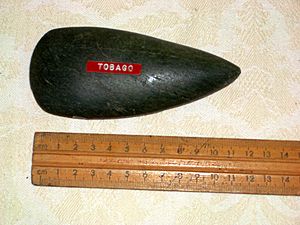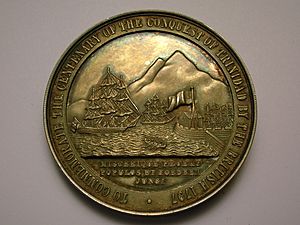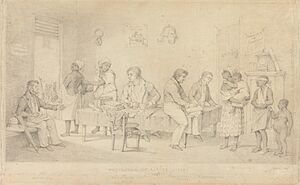History of Trinidad and Tobago facts for kids
The history of Trinidad and Tobago starts with the first people settling on the islands. Christopher Columbus visited Trinidad on his third trip in 1498. He claimed it for Spain, but he never landed on Tobago. Trinidad was ruled by Spain until 1797, but many French settlers moved there. Tobago was controlled by the British, French, Dutch, and Courlanders at different times. It finally became British after the second Treaty of Paris (1814). In 1889, Trinidad and Tobago became one country. They gained independence from the British Empire in 1962 and became a republic in 1976.
Contents
Early History of Trinidad and Tobago
People have lived in Trinidad for at least 7,000 years. The first settlers, called Archaic or Ortoiroid people, likely came from Venezuela in South America around 4000 BC. Many ancient sites have been found, mostly in southern Trinidad and Tobago. This includes the 7,000-year-old Banwari Trace site, which is the oldest human settlement found in the eastern Caribbean. These early people did not use pottery and lived in the area until about 200 BC.
Around 250 BC, the first people in the Caribbean to use pottery, the Saladoid people, arrived in Trinidad and Tobago. They are thought to have moved north from Trinidad and Tobago to other Caribbean islands. Many Saladoid sites have been found across Trinidad and Tobago.
After 250 AD, another group called the Barrancoid people settled in southern Trinidad and Tobago. They had moved up the Orinoco River from the sea. The oldest Barrancoid settlement was likely at Erin on the south coast.
Around 1300 AD, a new group, the Mayoid people, settled in Trinidad and Tobago. They brought new cultural ideas that replaced the older ones. These were the native tribes living in Trinidad and Tobago when Europeans arrived. They included the Nepoya and Suppoya (who spoke Arawak) and the Yao (who spoke Carib). They are generally known as Arawaks and Caribs. Many of them were sadly wiped out by the Spanish under a system called encomienda. This system forced Indigenous people to work for the Spanish in exchange for "protection" and Christian teaching. The few who survived were first gathered into missions by friars and then slowly became part of the wider society.
Spanish Rule
Columbus Arrives
The first time Europeans came to Trinidad was when Christopher Columbus arrived on 31 July 1498. He was on his third voyage of exploration. He landed at a place he called Point Galera and named the island Trinidad. He then sailed into the Gulf of Paria. Columbus saw Tobago on 14 August 1498 but did not land there. He named it Belaforme, meaning "beautiful" from a distance.
Spanish Settlements in Trinidad
Trinidad was said to have many people living there when the Europeans first arrived. However, in 1511, the Spanish declared the Indigenous people "Caribs," which meant they could be captured and sold as slaves. This was to supply workers for pearl fishing in nearby Isla Margarita.
In 1530, Antonio Sedeño tried to set up a settlement in Trinidad. He hoped to find the legendary El Dorado and control the slave trade. In 1532, he tried to build a town but was driven away by the Indigenous people. He tried again in 1533 but failed to attract enough settlers.
In 1592, Antonio de Berrio started the first lasting Spanish settlement, the town of San José de Oruña (now St. Joseph). Sir Walter Raleigh, also looking for El Dorado, arrived in Trinidad in 1595. He attacked San José and questioned de Berrio to get information.
The Spanish colony was small and poor. By 1625, there were only 24 Spanish settlers. They often traded with English, French, and Dutch ships, even though it was against Spanish rules. In 1637, the Dutch attacked St. Joseph easily. By 1772, the capital, St. Joseph, was still mostly mud huts. The island was not rich, and many people left.
In 1777, the Captaincy General of Venezuela was created. This gave more control to the provinces of Venezuela, including Trinidad, which had been part of a larger Spanish territory.
Spanish Settlements in Tobago
Tobago also saw many attempts at settlement. The first Dutch colony in 1628 did not last long. Several attempts by Courland (a small European country) and England also failed.
In 1654, Courland and Dutch colonies were successfully restarted. The Courland colony was called Neu-Kurland. The Dutch colony had three forts. In 1659, the Courlanders peacefully gave their colony to the Dutch. At this time, Tobago had about 1,500 Europeans and 7,000 African slaves working on plantations.
British pirates captured the island in 1666. Then the French took it. The Dutch reclaimed it in 1667. The British attacked and destroyed the Dutch colony in 1672 during a war. The Dutch regained control in 1674, but the French captured the island again in 1677.
In 1749, Britain and France agreed to keep Tobago neutral. But Britain took control after 1763. France captured it in 1781, and Britain took it back in 1793. By 1791, Tobago had 15,020 people, with most of them being slaves. The island became British for good in 1802, confirmed by a treaty in 1814.
Spanish Missions in Trinidad
Spanish missions were set up to convert the Indigenous people to Christianity. In 1687, Capuchin friars were given this job. However, problems between the priests and Indigenous people led to the Arena Massacre in 1699. After this, the missions were managed by other clergy. Due to a lack of missionaries, many missions did not have Christian teaching for long periods.
Several missions were founded between 1687 and 1700. Only four survived as Indigenous villages throughout the 18th century. These included places like modern Princes Town and San Fernando. The mission of Santa Rosa de Arima was started in 1789.
French Settlement in Trinidad
Even though Spanish settlement began in the 1500s, only 2,763 people lived on the island in 1777, including about 2,000 Arawaks.
In 1777, a plan was made to encourage French planters from other Caribbean islands to move to Trinidad with their African slaves. The Spanish offered many benefits to attract settlers. These included not having to pay taxes for ten years and getting land grants. In 1783, a law called the Cedula of Population gave 32 acres of land to every Roman Catholic who settled in Trinidad. They got half that amount for each slave they brought. Uniquely, 16 acres were offered to each Free Coloured person (people of mixed race who were not slaves), and half that for each slave they brought.
French planters, their slaves, and free people of color from nearby islands like Grenada and Martinique moved to Trinidad during the French Revolution. They created new communities like Blanchisseuse and Laventille. This led to Trinidad having a unique group of French-speaking free people of color who owned slaves.
By 1797, when the British took over, the population had grown to 17,643 people. This included many African slaves. The island had many sugar, coffee, cocoa, and cotton farms, but it was not well protected.
British Rule
In 1797, a British force led by General Sir Ralph Abercromby invaded Trinidad. The Spanish Governor Chacón decided to surrender without a fight. Trinidad then became a British crown colony. It had a French-speaking population but still used Spanish laws. British rule was officially recognized in 1802.
British rule brought many new settlers from the United Kingdom and other British colonies. People from England, Scotland, Ireland, Germany, and Italy arrived. New farms were started, and more slaves were brought in. However, this was also a time when people in England were fighting to end slavery. Slavery was officially abolished in 1833. After this, former slaves worked as "apprentices" until full freedom came on 1 August 1838. In 1838, Trinidad had only 17,439 slaves, much fewer than larger islands like Jamaica.
On 20 October 1889, the British Government made Tobago a part of Trinidad.
End of Slavery
In August 1816, seven hundred former slaves from the U.S.A. arrived in Trinidad. They had served in the British military. They were given land and settled in villages.
In Trinidad and Tobago, like other Caribbean slave colonies, there was an attempt to delay the full end of slavery. In 1833, the British government announced that slaves would be completely free by 1840. Until then, slaves were expected to work as "apprentices" for six more years.
However, Trinidad and Tobago showed a successful example of peaceful protest. On 1 August 1834, a group of mostly older former slaves chanted "Not six years. No six years" to the governor. They drowned out his voice.
Peaceful protests continued until a decision was made to end the apprenticeship early. Full freedom was granted on 1 August 1838. This was partly due to the influence of Dr. Jean Baptiste Phillipe, who was the first person of color on the Council. He proposed ending apprenticeship, and it was passed.
Farming and Indentured Workers
The sugarcane farms that were important in Trinidad and Tobago in the 1800s slowly gave way to growing cocoa. Trinidad and Tobago chocolate became very popular. The government opened up land for settlers who wanted to start cocoa farms. French Creoles (white Trinidadians from the original French settlers) found new economic opportunities in cocoa.
Farmers from Venezuela who knew how to grow cocoa were also encouraged to settle in Trinidad and Tobago. They provided much of the early labor on these farms. Many cocoa-growing areas in Trinidad still have a Spanish feel today.
In 1844, the British Government allowed 2,500 Indian workers to come to Trinidad as indentured servants. This meant they worked for a set period in exchange for passage and a small wage. This was done to get a steady supply of workers. Between 1838 and 1917, 145,000 Indians came to Trinidad. Workers also came from China around the same time. Many Indian immigrants who finished their work contracts also started their own cocoa farms. One famous example was Haji Gokool Meah, who became very wealthy. The Indian community has grown and is now about 35% of the country's population.
However, diseases like witches' broom and black pod hit the cocoa industry in the 1930s. This, along with the Great Depression, severely damaged the cocoa industry in Trinidad and Tobago. Today, cocoa is only a small crop. Relations between Indian immigrants and both the British and black populations were often difficult, sometimes leading to violence, like the 1884 Hosay massacre.
Discovery of Oil
The American Merrimac Oil Company drilled an early oil well in La Brea, Trinidad and Tobago, in 1857. Oil was found at 280 feet deep. In the 1860s, Walter Darwent also found and produced oil in Aripero. Early efforts to produce oil were not well funded and stopped after Darwent died.
In 1893, Randolph Rust and Lee Lum drilled a successful well near Darwent's original site. By early 1907, major drilling began, and roads were built. Annual oil production in Trinidad and Tobago reached 47,000 barrels by 1910 and quickly grew each year. In 2005, Trinidad and Tobago produced about 150,000 barrels of oil per day.
20th-Century Political Changes
Trinidad was ruled as a Crown colony without elected representatives until 1925. Tobago had an elected assembly, but it was dissolved before the islands joined. In 1925, the first elections for the Legislative Council were held. Only some members were elected, and voting was limited to certain men and women. In 1946, all adults could vote for the first time.
Labour Movement
Worker protests in 1937, led by T.U.B. Butler, shook the country. These protests led to the start of the modern Trade Union movement. Butler was jailed during World War II. After his release in 1945, he reorganized his political party. His party won the most votes in the 1950 elections, but the government feared him. Instead, Albert Gomes became the first Chief Minister of Trinidad and Tobago.
Representative Government
The 1956 elections saw the rise of the People's National Movement (PNM), led by Eric Williams. The PNM became very powerful and won every election between 1956 and 1981. Williams became prime minister when the country gained independence and stayed in that job until he died in 1981.
Federation
In 1958, the United Kingdom tried to create an independent West Indies Federation with most of its Caribbean colonies. However, there were disagreements, and Jamaica decided to leave. Eric Williams famously said, "One from ten leaves nought," meaning that without Jamaica, the federation would not work. Trinidad and Tobago chose not to pay for the federation without Jamaica's help, and so the Federation broke apart.
Independence
Trinidad and Tobago became fully independent on 31 August 1962. It remained part of the Commonwealth, with Queen Elizabeth II as its head of state. On 1 August 1976, the country became a republic. The last Governor-General, Sir Ellis Clarke, became the first President.
Oil Boom and Bust
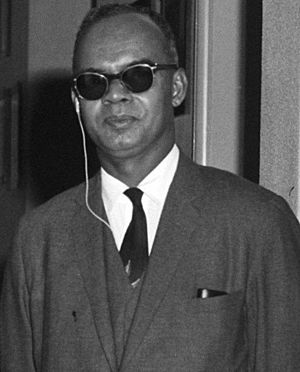
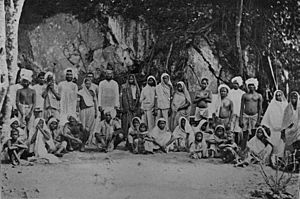
High oil prices in the 1970s and early 1980s led to an oil boom. This meant that salaries increased, living standards improved, but there was also more corruption.
In 1979, construction began on the Eric Williams Plaza, which became the tallest building in Trinidad and Tobago until 2003.
Eric Williams died in office in 1981. The PNM stayed in power for a while after his death. But their 30-year rule ended in 1986. The National Alliance for Reconstruction (NAR), a group that aimed to unite people of African and Indian descent, won a huge victory. Tobago's A. N. R. Robinson, the NAR leader, became prime minister. The NAR later started to break apart when its Indian members left in 1988.
1990 Coup Attempt
In July 1990, a group called the Jamaat al Muslimeen tried to overthrow the NAR government. The group held the prime minister and members of parliament hostage for five days. There were riots in Port of Spain. After a long standoff, the group's leader, Yasin Abu Bakr, and his followers surrendered. The courts later decided that an amnesty (a pardon) given to the group during the crisis was valid, and the members were released.
Recent Developments
In December 1991, the PNM, led by Patrick Manning, won the elections. Manning became the new Prime Minister. In November 1995, Manning called early elections. The PNM and the United National Congress (UNC) each won 17 seats. The UNC teamed up with the NAR to form a new government. Basdeo Panday, the UNC leader, became prime minister. He was the first prime minister of Indian descent.
Basdeo Panday was Prime Minister from 1995 to 2001. Elections in December 2000 saw the UNC win again. However, the UNC government fell in October 2001 due to corruption claims. The December 2001 elections resulted in a tie between the UNC and the PNM. President Robinson appointed Patrick Manning as Prime Minister, even though the UNC had won more votes. Manning called new elections in October 2002, which the PNM won.
Patrick Manning was Prime Minister from 1991 to 1995 and again from 2001 to 2010.
On 26 May 2010, Kamla Persad-Bissessar became the country's first female prime minister. On 9 September 2015, Dr. Keith Rowley was sworn in as the new Prime Minister after his PNM party won the election.
On 19 March 2018, Trinidad's first female President, Ms. Paula-Mae Weekes, was sworn into the mostly ceremonial role. In August 2020, the PNM won the general election again, meaning Prime Minister Keith Rowley would serve a second term.
See also
 In Spanish: Historia de Trinidad y Tobago para niños
In Spanish: Historia de Trinidad y Tobago para niños
- Spanish colonization of the Americas
- Dutch colonization of the Americas
- Curonian colonization of the Americas
- British colonization of the Americas
- French colonization of the Americas
- History of the British West Indies
- List of governors of the Windward Islands
- List of prime ministers of Trinidad and Tobago
- West Indies Federation
- Naval Base Trinidad (1941–1977)


